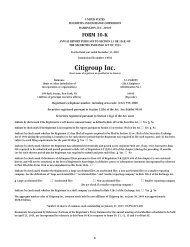FRANkLiN TEMPLETON INVESTMENT FUNDS - Citibank
FRANkLiN TEMPLETON INVESTMENT FUNDS - Citibank
FRANkLiN TEMPLETON INVESTMENT FUNDS - Citibank
Create successful ePaper yourself
Turn your PDF publications into a flip-book with our unique Google optimized e-Paper software.
PROSPECTUS OF FRANKLIN <strong>TEMPLETON</strong> <strong>INVESTMENT</strong> <strong>FUNDS</strong><br />
A Fund may own securities of different types, or from different asset classes—equities, bonds, money market<br />
instruments, derivatives—depending on the Fund’s investment objective.<br />
Different investments have different types of investment risk. The Funds also have different kinds of risk,<br />
depending on the securities they own. Below is a summary of the various types of investment risk that<br />
may be applicable to the Funds. Please refer to the Simplified Prospectus of the Company for details as to<br />
principal risks applicable to each Fund.<br />
Biotechnology, Communication and Technology Sectors Risk<br />
Investment in the biotechnology, communication and technology sectors may present a greater risk and a<br />
higher volatility than investment in a broader range of securities covering different economic sectors. In<br />
addition, these sectors may be subject to greater government regulation than other sectors and, as a result,<br />
changes to such government regulation may have a material adverse effect on these sectors. Such investments<br />
may therefore drop sharply in value in response to market, regulatory or research setbacks in addition to<br />
possible adverse effects from the competition of new market entrants, patent considerations and product<br />
obsolescence. Particularly within technology, short product cycles and diminishing profit margins are<br />
additional factors to consider when investing.<br />
Class Hedging Risk<br />
The Company may engage in currency hedging transactions with regards to a certain Class of Shares (the<br />
“Hedged Share Class”). Hedged Share Classes are designed (i) to reduce exchange rate fluctuations between<br />
the currency of the Hedged Share Class and the base currency of the Fund or (ii) to reduce exchange rate<br />
fluctuations between the currency of the Hedged Share Class and other material currencies within the<br />
Fund’s portfolio.<br />
The hedging will be undertaken to reduce exchange rate fluctuations in case the base currency of the<br />
Fund or other material currencies within the Fund (the “reference currency(ies)”) is(are) declining or<br />
increasing in value relative to the hedged currency. The hedging strategy employed will seek to reduce as<br />
far as possible the exposure of the Hedged Share Classes and no assurance can be given that the hedging<br />
objective will be achieved. In the case of a net flow to or from a Hedged Share Class the hedging may not<br />
be adjusted and reflected in the net asset value of the Hedged Share Class until the following or a subsequent<br />
business day following the Valuation Day on which the instruction was accepted.<br />
This risk for holders of any Hedged Share Class may be mitigated by using any of the efficient portfolio<br />
management techniques and instruments (including currency options and forward currency exchange<br />
contracts, currency futures, written call options and purchased put options on currencies and currency<br />
swaps), within the conditions and limits imposed by the Luxembourg financial supervisory authority.<br />
Investors should be aware that the hedging strategy may substantially limit Shareholders of the relevant<br />
Hedged Share Class from benefiting from any potential increase in value of the Share Class expressed in<br />
the reference currency(ies), if the Hedged Share Class currency falls against the reference currency(ies).<br />
Additionally, Shareholders of the Hedged Share Class may be exposed to fluctuations in the net asset<br />
value per Share reflecting the gains/losses on and the costs of the relevant financial instruments. The<br />
gains/losses on and the costs of the relevant financial instruments will accrue solely to the relevant<br />
Hedged Share Class.<br />
Any financial instruments used to implement such hedging strategies with respect to one or more Classes<br />
of a Fund shall be assets and/or liabilities of such Fund as a whole, but will be attributable to the relevant<br />
Class(es) and the gains/losses on and the costs of the relevant financial instruments will accrue solely to<br />
the relevant Class. However, due to the lack of segregated liabilities between Classes of the same Fund,<br />
costs which are principally attributed to a specific Class may be ultimately charged to the Fund as a whole.<br />
Any currency exposure of a Class may not be combined with or offset against that of any other Class of a<br />
Fund. The currency exposure of the assets attributable to a Class may not be allocated to other Classes.<br />
No intentional leveraging should result from currency hedging transactions of a Class although hedging<br />
www.franklintempleton.lu 33

















